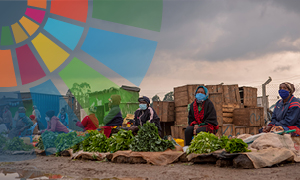The number of people who go to bed hungry was rising steadily prior to the COVID-19 pandemic due to stresses related to climate, inequality and conflict, and now stands at 690 million. The pandemic has supercharged these trends. The latest UN estimates are sobering, with an additional 130 million projected to be suffering from hunger, even before the devastating pandemic numbers we are currently seeing from India and Brazil. Worse, official development assistance (ODA) efforts in agriculture and food security have not coped with the increasing challenges. Between 2008 and 2018, their share in total ODA grants decreased from 9% to 8%. By neglecting the root cause of hunger, the global community has had to increase their spending on emergency food aid (which rose by 25% over the same period). What’s more, no African country is on track to meet the commitment to allocate at least 10% of annual public expenditure to agriculture.
But as the ground-breaking Ceres2030 studies—backed up by another study by German organizations, the PARI Report—show, this situation can be turned around. With $33 billion in additional annual spending, we can reduce the number of hungry people from 690 million today to 170 million by 2030. Not quite the end of hunger, but a reduction in the percentage of people that are hungry from 9% today to 3% in 2030.
Most of this additional money will come from governments, which must step up their commitments to the fight against hunger—but they are under pressure from the pandemic and the associated economic downturn. Large companies can and should step in as well to play a catalytic role in this effort. So far, the private sector has been waiting and watching. Now we need visionary companies to step up and join us. While many businesses have suffered in the past 12 months, others have prospered and are in a strong position to support ending hunger by 2030. For example, the NASDAQ has risen in value by 64% in the past year and the S&P 500 by 49%.
Companies will be able to signal their support by signing the “End Hunger, Nourish the Future Pledge” to align company investment and spending more strongly with the 10 high impact investment areas outlined by Ceres2030 below.
The “End Hunger, Nourish the Future Pledge” is being developed by colleagues at the International Institute for Sustainable Development (IISD), IFPRI, the Global Alliance for Improved Nutition (GAIN), Grow Africa, and Grow Asia, working with business associations, member states, donors and others in the context of the upcoming UN Food Systems Summit.
The action outlined by Ceres2030 takes place across three broad areas: Investments to empower the excluded (for example: strengthen farmer organizations, education for rural youth, social protection); investments on the farm (for example, farm extension, irrigation, finance, infrastructure, R&D, production subsidies); and investments for food on the move (for example, infrastructure and technical assistance to help small and medium enterprises, investment in storage and sustainable energy and cold chains).
Business participation would be highly catalytic, helping us to arrive at the additional $33 billion investment faster, which will spur an extra $52 billion in local private investment per year. The investments would also double the incomes of 545 million food producers and their families, and help limit greenhouse gas emissions for agriculture to the commitments agreed upon in the Paris Climate Agreement.
Investments at this level would also be a boon for the businesses themselves—helping to expand the very markets that have the most growth potential for many companies while also building important relationships with value chain actors and strengthening supply assurance. Pledging will help them to attract top talent among young, skilled professionals who have consistently expressed a desire to join companies that have a higher sense of purpose; and can boost companies’ environmental, social, and governance (ESG) profiles, which are becoming ever more important to the investment community.
Here is a chance for companies to give their words action: To stimulate local private sector investment. To help new markets flourish. To build new trusting relationships with value chain actors. To give their own employees a higher sense of purpose. To be the final spark for the final effort to end the obscenity of hunger. To be the, perhaps unlikely, champions that end hunger—for good.
Lawrence Haddad is Executive Director of the Global Alliance for Improved Nutrition (GAIN); Carin Smaller is Director of Agriculture, Trade, and Investment at the International Institute for Sustainable Development (IISD). Opinions expressed are those of the authors.







